
Warcraft III: Reign of Chaos is a high fantasy real-time strategy computer video game developed and published by Blizzard Entertainment released in July 2002. It is the second sequel to Warcraft: Orcs & Humans, after Warcraft II: Tides of Darkness, the third game set in the Warcraft fictional universe, and the first to be rendered in three dimensions. An expansion pack, The Frozen Throne, was released in July 2003. Warcraft III is set several years after the events of Warcraft II, and tells the story of the Burning Legion's attempt to conquer the fictional world of Azeroth with the help of an army of the Undead, led by fallen paladin Arthas Menethil. It chronicles the combined efforts of the Human Alliance, Orcish Horde, and Night Elves to stop them before they can corrupt the World Tree.
Real-time strategy (RTS) is a subgenre of strategy video games that doesn't progress incrementally in turns, but allow all players to play simultaneously, in "real time". By contrast, in turn-based strategy (TBS) games, players take turns to play. The term "real-time strategy" was coined by Brett Sperry to market Dune II in the early 1990s.

Total War is a series of strategy games developed by British developer Creative Assembly for personal computers. They combine turn-based strategy and resource management with real-time tactical control of battles. Rather uniquely for real-time strategy games, flanking manoeuvers and formations factor heavily into gameplay. The first of the series, Shogun: Total War, was released in June 2000. The most recent major game released was Total War: Pharaoh on October 11, 2023. As of April 2021, the series had sold over 36 million copies.
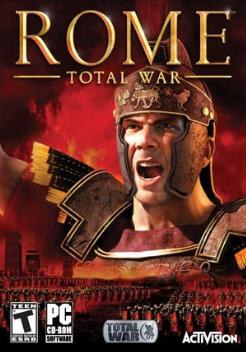
Rome: Total War is a strategy video game developed by The Creative Assembly and originally published by Activision; its publishing rights have since passed to Sega. The game was released for Microsoft Windows in 2004. The macOS version was released on February 5, 2010, by Feral Interactive, who also released the iPad version on November 10, 2016, the iPhone version on August 23, 2018, and the Android version on December 19, 2018. The game is the third title in The Creative Assembly's Total War series, following Shogun: Total War, and Medieval: Total War.

Caesar III is a city-building game released on September 30, 1998, for Microsoft Windows and Mac OS, developed by Impressions Games and published by Sierra On-Line. It is the third installment of the Caesar series of games and is part of Sierra's City Building series. Players assume the role of a provincial governor to build thriving cities across the Roman Empire, in which they must ensure their citizens have their needs met, and deal with various disasters, angry gods and hostile enemies. The developers of Caesar III designed the game in response to critiques of its predecessor, introducing branching missions, a merged map for city-building and combat, and a "walker" mechanic for citizens of the city to affect their surroundings. Caesar III was released to positive critical reception, with praise directed at the game's visual presentation and complex design, and criticism levelled at its military features.
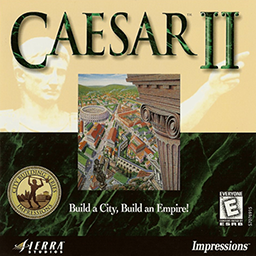
Caesar II is a 1995 video game of the Caesar video game series that takes place in Ancient Rome. It is the second game in the City Building series.
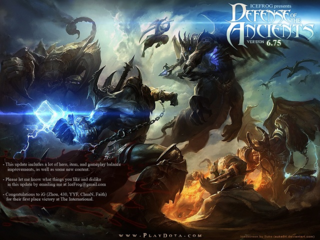
Defense of the Ancients (DotA) is a multiplayer online battle arena (MOBA) mod for the video game Warcraft III: Reign of Chaos (2002) and its expansion, The Frozen Throne. The objective of the game is for each team to destroy their opponents' Ancient, a heavily guarded structure at the opposing corner of the map. Players use powerful units known as heroes, and are assisted by allied teammates and AI-controlled fighters. As in role-playing games, players level up their heroes and use gold to buy equipment during the game.

Pharaoh is an isometric city-building game that was released on November 5, 1999. It was created by Impressions Games and published by Sierra Studios for Microsoft Windows. Using the same game engine and principles of Caesar III, it is the first such game in Sierra's City Building series to focus on another civilization of ancient times. Players oversee the construction and management of cities and settlements in Ancient Egypt, micro-managing every aspect of the city to ensure citizens are fed, employed, healthy and protected from diseases, disasters and wars. An expansion pack, Cleopatra: Queen of the Nile, was released in 2000, developed by BreakAway Games. In 2001, both the game and expansion pack were bundled together as Pharaoh Gold. A remake titled Pharaoh: A New Era was released by Triskell Interactive and Dotemu in 2023.

Rise and Fall: Civilizations at War is a real-time strategy video game developed by both Stainless Steel Studios and Midway Games which was released on June 12, 2006. The game incorporates segments of both third-person and first-person shooter gameplay, by allowing the player to temporarily control a "hero". Rise and Fall is based in the first millennium BC, and features four playable civilizations: Persia, Greece, Egypt, and Rome. The game includes over eighty civilization-unique military units, as well as eight "hero" units—of which only one may be purchased during a game. In Rise and Fall, there are two campaigns: one follows the conquests of Alexander the Great; and the other, the fictional liberation of Egypt by Cleopatra.

CivCity: Rome is a city building strategy game by Firefly Studios and Firaxis Games. It includes elements from two game series, Caesar and Civilization.

Rome: Total War: Alexander is the second expansion pack for Rome: Total War. It is set in an earlier time period, putting the player in the role of Alexander the Great. It begins with Alexander's ascension to the Macedonian throne in 336 BC and lasts for 100 turns. The game is much the same as the original Rome: Total War, but with fewer factions, different units, and a different map. The expansion was released in 2006 for Microsoft Windows. The macOS version of Rome: Total War: Alexander was released on 27 February 2014 by Feral Interactive. A standalone version of the expansion, also by Feral, was released for the iPad on 27 July 2017. An iPhone and Android version of the game was released on 24 October 2019.
Strategy is a major video game genre that emphasizes thinking and planning over direct instant action in order to achieve victory. Although many types of video games can contain strategic elements, as a genre, strategy games are most commonly defined as those with a primary focus on high-level strategy, logistics and resource management. They are also usually divided into two main sub-categories: turn-based and real-time, but there are also many strategy cross/sub-genres that feature additional elements such as tactics, diplomacy, economics and exploration.

Longbow 2 is the sequel to Jane's AH-64D Longbow from Jane's Combat Simulations. The game was developed by Origin Systems with executive producer Andy Hollis on board, and released by Electronic Arts on November 13, 1997.

Grand Ages: Rome is a 2009 city-building and real-time strategy game developed by Haemimont Games and published by Kalypso Media. It is the sequel to 2008's Imperium Romanum. The Italian and Spanish versions of the game are titled as Imperivm: Civitas III. A sequel, Grand Ages: Medieval, was released on September 25, 2015.

Age of Empires (AoE) is a real-time strategy video game based on history, developed by Ensemble Studios and published by Microsoft, and the first game in the Age of Empires series. The game uses the Genie Engine, a 2D sprite-based game engine. The game allows the user to act as the leader of an ancient civilization by advancing it through four ages, gaining access to new and improved units with each advance.
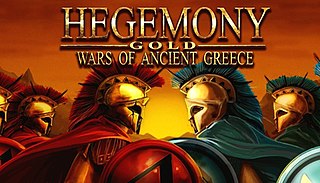
Hegemony Gold: Wars of Ancient Greece is a real-time strategy game developed and published by Canadian studio Longbow Digital Arts Inc. It began as Hegemony: Philip of Macedon which revolved around the campaigns of Philip II of Macedon. It was originally released on Windows on 11 May 2010. It was updated as Hegemony Gold: Wars of Ancient Greece on 23 February 2011 which added scenarios set in the Peloponnesian War. The game features simultaneous real-time tactical battles and real-time strategic empire management, with a focus on the logistics and planning of military campaigns. It was followed by Hegemony Rome: The Rise of Caesar in May 2014 and Hegemony III: Clash of the Ancients in August 2015. A DLC for Clash, The Eagle King, was released in February 2017.
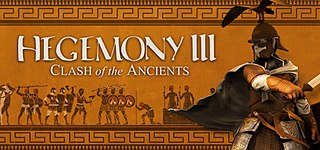
Hegemony III: Clash of the Ancients is the third installment in the Hegemony strategy video game series, which was developed by the Canadian studio Longbow Games and released for Windows on August 25, 2015.
Longbow Games is a Canadian video game developer based in Toronto. It was founded in 1998 by Seumas McNally.

Hegemony Rome: The Rise of Caesar is a 2014 historical real-time strategy video game developed by Longbow Digital Arts and published by Kasedo Games for Microsoft Windows. Like its 2010 prequel Hegemony Gold: Wars of Ancient Greece, it combines tactical real-time battles and strategic empire management while focusing on logistics and planning of military campaigns. Hegemony Rome is set in the period of the Gallic Wars during the campaigns of Julius Caesar, proconsul of Gaul and Illyria.
















